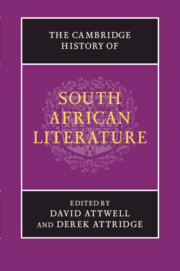Book contents
- Frontmatter
- Introduction
- PART I ORATURES, ORAL HISTORIES, ORIGINS
- PART II EXPLORATION, EARLY MODERNITY AND ENLIGHTENMENT AT THE CAPE, 1488–1820
- PART III EMPIRE, RESISTANCE AND NATIONAL BEGINNINGS, 1820–1910
- PART IV MODERNISM AND TRANSNATIONAL CULTURE, 1910–1948
- PART V APARTHEID AND ITS AFTERMATH, 1948 TO THE PRESENT
- PART VI SOUTH AFRICAN LITERATURE: CONTINUITIES AND CONTRASTS
- 33 South Africa in the global imaginary
- 34 Confession and autobiography
- 35 ‘A change of tongue’: questions of translation
- 36 Writing women
- 37 The experimental line in fiction
- 38 The book in South Africa
- 39 Literary and cultural criticism in South Africa
- Index
- References
38 - The book in South Africa
from PART VI - SOUTH AFRICAN LITERATURE: CONTINUITIES AND CONTRASTS
Published online by Cambridge University Press: 28 January 2012
- Frontmatter
- Introduction
- PART I ORATURES, ORAL HISTORIES, ORIGINS
- PART II EXPLORATION, EARLY MODERNITY AND ENLIGHTENMENT AT THE CAPE, 1488–1820
- PART III EMPIRE, RESISTANCE AND NATIONAL BEGINNINGS, 1820–1910
- PART IV MODERNISM AND TRANSNATIONAL CULTURE, 1910–1948
- PART V APARTHEID AND ITS AFTERMATH, 1948 TO THE PRESENT
- PART VI SOUTH AFRICAN LITERATURE: CONTINUITIES AND CONTRASTS
- 33 South Africa in the global imaginary
- 34 Confession and autobiography
- 35 ‘A change of tongue’: questions of translation
- 36 Writing women
- 37 The experimental line in fiction
- 38 The book in South Africa
- 39 Literary and cultural criticism in South Africa
- Index
- References
Summary
In 1980 the University of Cape Town offered its final-year undergraduates a specialist option entitled ‘The Book in Africa’ as part of its new African Literature programme. In his prospectus, the convenor, J. M. Coetzee, noted that it was a novel and potentially risky choice for students:
We will be exploring some of the determinants of literary production not often dealt with in literary studies: environmental pressures of all kinds on writers, the economics of publishing and distributing literary works, the nature of the readership of literary works, etc. Since much of the information required for this kind of study is not readily available, students are forewarned that the course will entail a certain amount of bibliographical ferreting and a certain amount of practical investigative research. (‘Book in Africa’)
There was, indeed, much ferreting. Among other things, Coetzee encouraged students to investigate ‘the location of bookstores in the Cape Peninsula and the types of clientele they serve’; ‘the library services in the black residential areas of the Cape’; the histories and editorial policies of a number of ‘South African literary magazines’, including Bolt (1970–5), Classic (1963–71), Contrast (1960–), Izwi (1971–4), New Classic (1975–8), New Coin (1965–), Ophir (1967–76), Purple Renoster (1956–72) and Staffrider (1978–93). In addition, he suggested they might consider which ‘works by black South African writers’ the apartheid censors ‘tended to proscribe’ and which ones they ‘let through’; the ‘origin and development of the Heinemann African Writers series’; and, given the emphasis on South and West African contexts, he suggested that students might ‘compare and contrast Onitsha market literature with the South African fotoroman [photo-novel] in terms of themes and readership’.
- Type
- Chapter
- Information
- The Cambridge History of South African Literature , pp. 800 - 817Publisher: Cambridge University PressPrint publication year: 2012
References
- 1
- Cited by

